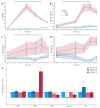The Role of Selenitetriglycerides in Enhancing Antioxidant Defense Mechanisms in Peripartum Holstein-Friesian Cows
- PMID: 38396578
- PMCID: PMC10886193
- DOI: 10.3390/ani14040610
The Role of Selenitetriglycerides in Enhancing Antioxidant Defense Mechanisms in Peripartum Holstein-Friesian Cows
Abstract
The transition period in high-yielding dairy cows is a critical phase marked by an elevated risk of oxidative stress. This study evaluated the effect of oral selenitetriglyceride supplementation on oxidative stress management in periparturient cows. A controlled experiment was conducted on 12 cows, divided into two groups: the experimental group (STG) received selenitetriglycerides (0.5 mg Se/kg BW), while the control group (CON) was given a placebo, starting 12 days before calving until the calving day. Blood and liver tissue samples were collected at predetermined intervals around the time of parturition. The study observed a significant increase in serum selenium levels and NEFA stabilization in the STG group compared with the control. Antioxidant parameters indicated elevated GSH-Px and CAT concentrations in the STG group. Liver gene expression analysis revealed a significant increase in SOD2 mRNA levels in the STG group (FC = 4.68, p < 0.01). Conversely, GSH-Px3 expression significantly decreased (FC = 0.10, p < 0.05) on the 7th day postpartum in the CON group. However, SOD1, SOD3, and CAT expressions remained stable in both groups. These findings highlight the beneficial role of selenitetriglycerides in enhancing antioxidant capacity and influencing specific gene expressions associated with oxidative stress management in dairy cows during the peripartum period.
Keywords: Holstein-Friesian cows; antioxidants; gene expression; peripartum period; selenitetriglycerides; selenium supplementation.
Conflict of interest statement
The authors declare no conflicts of interest.
Figures


Similar articles
-
Effect of Organic Selenium Supplementation on Selenium Status, Oxidative Stress, and Antioxidant Status in Selenium-Adequate Dairy Cows During the Periparturient Period.Biol Trace Elem Res. 2018 Dec;186(2):430-440. doi: 10.1007/s12011-018-1323-0. Epub 2018 Mar 29. Biol Trace Elem Res. 2018. PMID: 29594692
-
Persistently high concentrations of β-hydroxybutyrate affect hepatic SOD2 expression and blood SOD activity in high-yielding dairy cows.BMC Vet Res. 2025 Jan 9;21(1):12. doi: 10.1186/s12917-024-04464-3. BMC Vet Res. 2025. PMID: 39789575 Free PMC article.
-
The influence of short-term selenitetriglycerides supplementation on blood selenium, and hepatic, renal, metabolic and hematological parameters in dairy cows.Pol J Vet Sci. 2020 Dec;23(4):637-646. doi: 10.24425/pjvs.2020.135812. Pol J Vet Sci. 2020. PMID: 33480507
-
Evaluation of blood minerals and oxidative stress changing pattern in prepartum and postpartum Achai and Holstein Friesian dairy cows.Reprod Domest Anim. 2024 Jan;59(1):e14525. doi: 10.1111/rda.14525. Reprod Domest Anim. 2024. PMID: 38268211
-
Effect of a single, oral administration of selenitetriglycerides, at two dose rates, on blood selenium status and haematological and biochemical parameters in Holstein-Friesian calves.Ir Vet J. 2021 Apr 23;74(1):11. doi: 10.1186/s13620-021-00192-4. Ir Vet J. 2021. PMID: 33892796 Free PMC article.
Cited by
-
Under heat stress conditions, selenium nanoparticles promote lactation through modulation of rumen microbiota and metabolic processes in dairy goats.Sci Rep. 2025 Mar 17;15(1):9063. doi: 10.1038/s41598-025-93710-1. Sci Rep. 2025. PMID: 40097638 Free PMC article.
References
-
- Żarczyńska K., Żarczyński P., Sobiech P., Snarska A., Stopyra A., Wieteska M., Płaczek A. The effect of micronutrient deficiencies on the health status of transition cows. J. Elem. 2017;22:1223–1234. doi: 10.5601/jelem.2017.22.2.1447. - DOI
-
- Ponnampalam E.N., Kiani A., Santhiravel S., Holman B.W., Lauridsen C., Dunshea F.R. The importance of dietary antioxidants on oxidative stress, meat and milk production, and their preservative aspects in farm animals: Antioxidant action, animal health, and product quality—Invited review. Animals. 2022;12:3279. doi: 10.3390/ani12233279. - DOI - PMC - PubMed
-
- Jóźwik A., Krzyżewski J., Strzałkowska N., Bagnicka E., Poławska E., Horbańczuk J. Oxidative stress in high yielding dairy cows during the transition period. Med. Weter. 2012;68:468–474.
LinkOut - more resources
Full Text Sources
Miscellaneous

